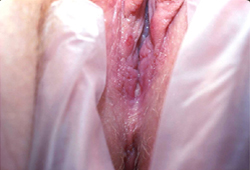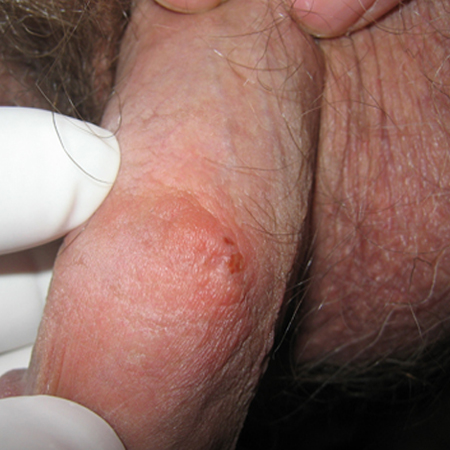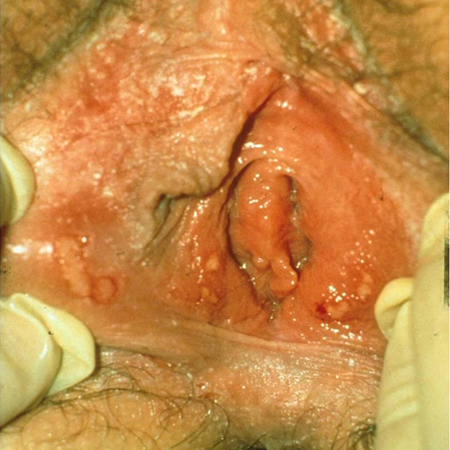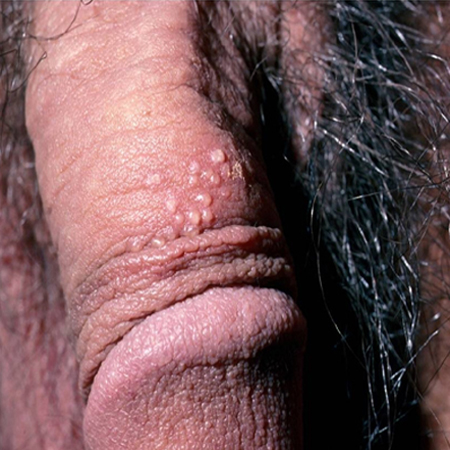Approach
Genital herpes and herpes labialis diseases require different approaches.
Genital herpes signs and symptoms
Clinical history and presentation have limited sensitivity in diagnosis; therefore, clinicians must have a high index of suspicion.[36] The symptoms are highly variable and may include recurrent dysuria, tingling and burning without lesions, or recurrent genital ulcerations. The physical examination similarly ranges from normal to subtle, asymptomatic fissures or ulcers in the genital mucosa during recurrences, to painful ulcerations.
The first clinical episode of genital ulceration may represent either a primary infection due to a new acquisition of the virus, in which the host lacks antibodies to both HSV-1 or HSV-2, or a non-primary first episode, where a new infection with one HSV subtype occurs in a patient who already has antibodies to the other HSV type (i.e., HSV-1 infection in a patient with antibodies to HSV-2 , or vice versa). A recurrent infection is an outbreak resulting from reactivation of the same type of virus.
HSV type 2 (HSV-2) is transmitted via sexual contact. Women may have genital pain, discharge, and dysuria with ulcerative lesions on the vulva, perineum, buttocks, cervix, and vagina.
During primary infection, women tend to have systemic symptoms, including fever, neuralgia, and constipation, whereas men tend to have a milder primary course. Neuralgia in women typically occurs in the genital area, in the lower back, or down the back of the legs during primary infection. Men may have vesicles on the penis shaft or glans with urethritis.
Proctitis may occur with discharge, rectal pain, tenesmus, constipation, impotence, and urinary retention after anorectal intercourse. About 90% of people with primary HSV-2 infection have recurrent episodes within the first year, with recurrences decreasing over time.[13]
[Figure caption and citation for the preceding image starts]: HSV-labial ulcerationFrom the personal files of Christine Johnston, MD, and Anna Wald, MD; used with permission [Citation ends]. [Figure caption and citation for the preceding image starts]: HSV-penile ulcerative lesionFrom the personal files of Christine Johnston, MD, and Anna Wald, MD; used with permission [Citation ends].
[Figure caption and citation for the preceding image starts]: HSV-penile ulcerative lesionFrom the personal files of Christine Johnston, MD, and Anna Wald, MD; used with permission [Citation ends]. [Figure caption and citation for the preceding image starts]: HSV-primary infection in a womanFrom the personal files of Christine Johnston, MD, and Anna Wald, MD; used with permission [Citation ends].
[Figure caption and citation for the preceding image starts]: HSV-primary infection in a womanFrom the personal files of Christine Johnston, MD, and Anna Wald, MD; used with permission [Citation ends]. [Figure caption and citation for the preceding image starts]: HSV-penile vesicular lesionFrom the personal files of Christine Johnston, MD, and Anna Wald, MD; used with permission [Citation ends].
[Figure caption and citation for the preceding image starts]: HSV-penile vesicular lesionFrom the personal files of Christine Johnston, MD, and Anna Wald, MD; used with permission [Citation ends].
Genital herpes testing
Genital herpes is caused by infection with either HSV type 1 (HSV-1) or HSV-2. If lesions are present, clinical diagnosis should be confirmed by swabbing lesions for HSV culture or HSV polymerase chain reaction (PCR).[37] Because of the higher sensitivity of PCR than of culture, PCR is the preferred test when available.[38] Other NAAT methods have shown similar results.[39] Do not use PCR testing to screen for genital HSV infection in asymptomatic patients. HSV shedding is intermittent, therefore PCR testing is unlikely to confirm the diagnosis if no lesions are present.[40][41]
Glycoprotein G-based type-specific serology (gG1 and gG2 for HSV-1 and HSV-2, respectively) may be useful to confirm diagnosis in patients with atypical complaints or previously undiagnosed genital ulcer disease.[42] US guidelines recommend two-step serological testing for HSV; commercially-available type-specific enzyme immunoassays may have poor specificity and a confirmatory test with a second-method (Western blot or Biokit) is advised.[37] Given the high false-positive rate, serological testing is not routinely recommended for screening in asymptomatic individuals in low prevalence settings, including pregnant patients.[37][43] Additionally, there is no role for IgM antibody testing, because it is not type-specific and cannot distinguish between primary versus recurrent episodes of HSV infection.[39]
Herpes labialis signs and symptoms
The incubation period of HSV-1 is between 2-12 days. Symptoms of primary HSV-1 may include high fever and sore throat. Painful ulcers can appear a few days later on the pharyngeal and oral mucosa.[44] The ulcers may be widespread, and high fever and mouth pain can last for several days. Generalised muscle pains may occur with cervical lymphadenopathy. However, the majority of patients have asymptomatic acquisition of HSV-1.
Recurrent disease often occurs in the same area and is frequently characterised by a prodrome of tingling and burning, followed by development of vesicles, then ulcerative lesions at the vermillion border.[45] Symptoms usually last for 6-48 hours. Systemic manifestations do not typically occur, and the lesions will crust and heal in about 10 days.
Recurrences may be induced by ultraviolet (UV) light or trauma.
Herpes labialis testing
The diagnosis can be made clinically, but HSV culture or PCR should be performed on active lesions if there is a question about the diagnosis.
Disseminated or CNS disease
HSV PCR on cerebrospinal fluid should be sent for all cases of suspected HSV central nervous system (CNS) involvement.[46] Serum HSV PCR may also be useful for diagnosis in certain cases of disseminated disease; however, viral cultures should be obtained from any active lesions, particularly in immunocompromised patients, to identify resistant viral isolates. Patients with CNS or disseminated disease should be managed with the assistance of an infectious disease consultant.
Use of this content is subject to our disclaimer